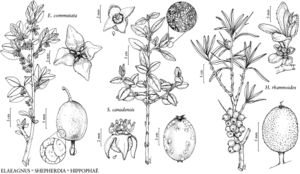Difference between revisions of "Hippophaë rhamnoides"
Sp. Pl. 2: 1023. 1753. (as Hippophae)
imported>Volume Importer |
imported>Volume Importer |
||
| Line 54: | Line 54: | ||
|publication year=1753 | |publication year=1753 | ||
|special status= | |special status= | ||
| − | |source xml=https://xjsachs2@bitbucket.org/aafc-mbb/fna-data-curation.git/src/ | + | |source xml=https://xjsachs2@bitbucket.org/aafc-mbb/fna-data-curation.git/src/e39f0e846f172941159b2045254d62d10d9823f6/coarse_grained_fna_xml/V10/V10_215.xml |
|genus=Hippophaë | |genus=Hippophaë | ||
|species=Hippophaë rhamnoides | |species=Hippophaë rhamnoides | ||
Latest revision as of 10:31, 9 May 2022
Trees or shrubs 3–6(–10) m, clonal, forming masses as broad as tall. Stems with terminal and axillary spines, spines 1–6 cm. Leaf blades 1–6 × 0.3–1 cm. Pedicels absent on staminate plants, present on pistillate plants. Flowers: sepals yellow, 3 mm, glabrous or sparsely pubescent. Fruits bright orange or yellow-orange, subglobose, 6–8 mm. Seeds orange-brown, oblong, 4–5 mm, shiny. 2n = 24.
Phenology: Flowering Apr–May; fruits often persisting through winter.
Habitat: Open areas, sandy loam or clay soils.
Elevation: 100–300 m.
Distribution
Introduced; Alta., Ont., Que., Sask., Yukon, c, n Europe, Asia.
Discussion
Hippophaë rhamnoides is planted for erosion control and as an ornamental; it does well in nutritionally poor soils and is potentially invasive. Because the species is dioecious, both staminate and pistillate plants must be planted for viable seeds to develop. Reports of the species in Wyoming are based on collections from gardens; it has not become naturalized in the area (R. Hartman, pers. comm.). M. A. Dirr (2009) called this one of the best plants available for winter fruit color, one that is also tolerant of salt-spray.
Selected References
None.
